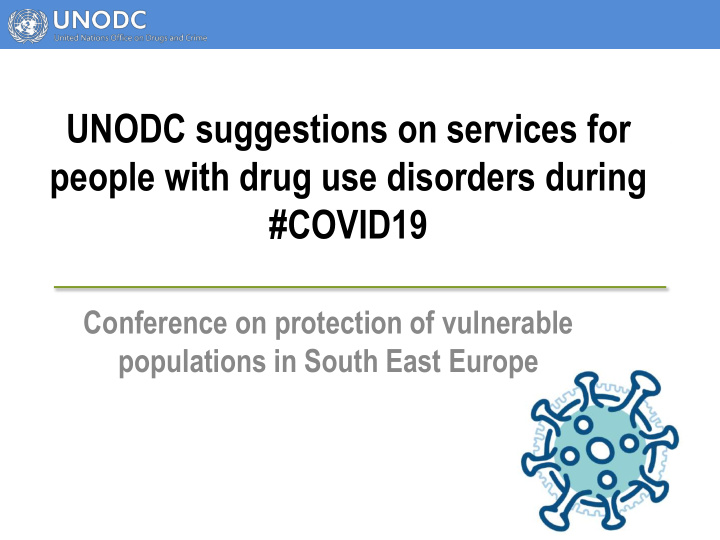



UNODC suggestions on services for people with drug use disorders during #COVID19 Conference on protection of vulnerable populations in South East Europe
Global situation – drug use • About 271 million people worldwide (5.5 % of the global population aged 15-64 years) used drugs at least once during 2016 (1:18 persons) • Some 35 million people who 1: 1:7 use drugs suffer from drug dependence (13% of people who use drugs) Access ss limite ted
International Standards for the Treatment of Drug Use Disorders (2020)
#COVID19 – Increasing challenges for treatment & care services • Treatment services not everywhere considered as part essential health care - Limited/no access to PPE • Supply of medications and services for pharmacological treatment of opioid use disorders • Reduced access/places in residential treatment services • Unstable internet connection for telemedicine • PWUD moving to more risky modes of consumption • Curfews affecting homeless/livelihoods people who use drugs • People with minor drug related crimes not necessarily included in compassionate prison release/alternative schemes
WHO health system preparedness
Available in 12 languages
Continued access of all medications, including: restocking, • providing delivery at home, take-home medication, extended prescriptions, and extended-release formulations. • Naloxone for those likely to witness an opioid overdose. • Opioid agonist maintenance therapy with methadone and buprenorphine (including extended release buprenorphine where available): increase the number of patients which are eligible for take-home doses If withdrawal is a concern, ensure people have access to • supportive medication. Consider continued access to symptomatic medications and medication for the treatment • of co-occurring disorders. For some highly motivated people with opioid use disorders or in places where • maintenance treatment with opioid agonists is not available, access to naltrexone for relapse prevention might be an option.
COVID-19 HIV Prevention https://www.unodc.org/unodc/en/hiv-aids/new/covid-19-and-hiv.html
COVID-19 HIV Prevention ( for people who use drugs)
Guidance on prisons and COVID19 • Preparedness for prison health services • Increased consideration for alternatives to conviction or punishment Consideration of compassionate and early release schemes •
COVID-19 and HIV (UNAIDS)
COVID-19 and HIV (UNAIDS) 1. Engage affected communities from the beginning in ALL response measures 2. Combat all forms of stigma and discrimination 3. Ensure access to free or affordable screening, testing and care for the most vulnerable and hard to reach. 4. Remove barriers to people protecting their own health and that of their communities 5. Restrictions to protect public health must be of limited duration, proportionate, necessary and evidence- based and reviewable by a court 6. Countries must work to support each other to ensure no country is left behind, sharing information, knowledge, resources and technical expertise. 7. Support and protect health care workers. Be kind to each other.
#Leaving no one behind • Milos.stojanovic@un. org FOLLOW US ON TWITTER! • @UNODC_PTRS https://www.unodc.org/unodc/en/drug-prevention-and-treatment/publications.html
Recommend
More recommend